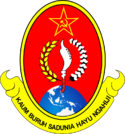Constitution of Sunda Raya
| Fundamental Law of the Democratic Republic of Sunda Raya | |
 | |
| Created | 28 February 2014 |
| Ratified | 2 March 2014 |
| Authors | Revolutionary Council of Sunda Raya |
| Signers | Representatives from the Regional Soviet of the Soviet Socialist Republic of Parahyangan, Soviet Socialist Republic of Pantai Selatan, Soviet Socialist Republic of Natuna, People's Soviet Socialist Republic of Madura, People's Republic of Sabah and Mindanao |
| Purpose | Constitution of Sunda Raya |
The Fundamental Law of the Democratic Republic of Sunda Raya, also known as Hukum Fundamental Republik Demokratik Sunda Raya, is the official title of the national constitution of the Democratic Republic of Sunda Raya.
It was written collectively by the Revolutionary Council of Sunda Raya during the First Congress of the Soviets on 28 February 2014 and it was ratified five days later.
History
On 25 February 2014, the First Congress of the Workers Coucil, led by Revolutionary Council of Sunda Raya issued a resolution calling for the consolidation of the workers councils and an establishment of a socialist government. Two days later, the congress proclaimed the establishment of the Democratic Republic of Sunda Raya, which later consisted of five federal entities. on 28 February 2014, the First Congress of the Workers Councils approved the Constitution of Sunda Raya, the integration of the non-sundanese workers councils, and the creation of Sunda Raya People's Army.
First Amendment
The first discussion about amendments started in July 2014. The Presidium of the council was pursuing a series of simplification reform in order to specifically define the role of the central government and the federal entities. After the failure of the NEP (New Economic Policy) experiment, the majority of soviets demand wider decentralization and simplification of government institutions.
In early August 2014, the Supreme Workers Council of Sunda Raya finally amended the Constitution. The first amendment resulted in the abolition of Sunda Raya People's Army and several government institutions. The office of the President of Sunda Raya was further merged with the Presidium of Supreme Workers Council.
Second Amendment
As the effort to implement 'New Way' politics started in early 2015, the call to amend the constitution arose. The most prominent supporter of the amendment are the federalist faction inside the PKP. Despite some objections from the centralists faction of Sundaner Maoists and Hoxhaists, the remaining upholder of Stalinism in Sunda Raya, the Supreme Workers Council, then the Supreme Workers Council, decided to amend the constitution.
The second amendment occurred in February 2015. The newly amended Constitution defines the role of the Central Workers Government and the federal entities. The greater autonomy is granted to the federal entities including the right to independently be involved in intermicronational relations and even the right to secede from the federation.
The amendments define the mechanism of the Council System and the power of the federal entities in their respective regions. The amendments give the rights to the federal entities to adopt their own constitution in accordance with the federal constitution and to set up its own administrative divisions. As a result, in mid 2016 several new entities arose inside some federal entities, such as Federation of Puncak Raya in Parahyangan and Autonomous Council Republic of Belitong in Natuna. Several government institutions was also renamed, such as renaming the soviets to workers councils etc.